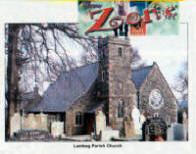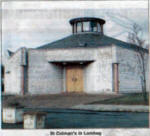
The rhythm of history still beats
This week Amanda Cunningham looks at the history of
Lambeg
02/03/01
 MENTION the word Lambeg to someone and the first thing that springs to mind is the famous Lambeg Drum.
MENTION the word Lambeg to someone and the first thing that springs to mind is the famous Lambeg Drum.
And yes,, the drums used on July 12 were manufactured in Lambeg, but that part of history was merely the tip of the iceberg.
Lambeg, according to the Ordinance Survey 'Memoirs of Ireland was founded around 1676. However, the earliest gravestone found in Lambeg Parish Church is dated 1626 and there are records of bleach green in Lambeg at that time established by native English and Scottish families.
In 1760„ Mr John Williamson owned most of the village and played a prominent role in the development of the linen trade, through ownership of the Lambeg bleach green.
In 1762 after writing an able treatise on trade, some discontented weavers decide that their employer was the enemy of the people and proceeded to surround his home and break the windows with threats of pulling the house down
 Glenmore House (once called Lambeg House) was left standing but because of ill feeling Mr. Williamson decided to give up, the bleaching works and the village to settle down in London.
Glenmore House (once called Lambeg House) was left standing but because of ill feeling Mr. Williamson decided to give up, the bleaching works and the village to settle down in London.
When his health deteriorated in later years however, he returned to Glenmore to be interred in Lambeg Churchyard.
Mr James Nicholson Richardson, another Baron of the linen industry, purchased the house in 1835.
The Richardson family were well liked and as well as owning the Lambeg Bleaching and Dyeing Company, they played an active part in parochial matters including the provision of a soup kitchen during the Great Famine of 1847.
 Seventy-year-old Geordie Williamson who has lived all his life in Lambeg Parish, remembers passing the Richardson's bleach green on the banks of the River Lagan'.
Seventy-year-old Geordie Williamson who has lived all his life in Lambeg Parish, remembers passing the Richardson's bleach green on the banks of the River Lagan'.
"Sometimes if we had two bob we would take the train to Lisburn to see the pictures. There were yards and yards of bleach linen' where Coca Cola Company is now," he said.
"At that time linen was the biggest employer, along with the shipyard in Belfast," he recalled.
A well known tale of King William the Third is on the lips of most older residents in Lambeg including Geordie.
He said. "William was on his way to the Battle of the Boyne. He was passing through Lambeg and while crossing the river one of his gun carriages broke down. His aids sent for Lambeg blacksmith Rene Bulmer to repair the damage.
"The King was delighted and surprised to hear Bulmer address him in perfect French and spent some time listening to the blacksmith's story of fleeing from his native France with the Huguenots during the 'Edit of Nantes."
The Wolfenden's were another foreign family who went into exile in Lambeg and assisted in the establishing of the manufacture of linen cloth in the village. They are buried in Lambeg graveyard.
The Lambeg bridge, which forms a communication between Antrim and Down, is still referred to as Wolfenden's Bridge.
Lambeg Parish Church dates back to the 13th century when it was once occupied by a Franciscian Monastery. At the time of Oliver Cromwell's reign in the mid-1600's the churchyard was the seat of an ancient nunnery.
For many years after the opening in 1935 Lambeg Orange Hall was a central part of the community and Geordie has been a member for 55 years.
The villagers were badly affected in August 1995 when the hall was burnt to the ground in a terrorist attack.
Over the years many buildings have been renovated in Lambeg. Glenmore House was bought by the Linen Industry Research Association (LIRA) in 1919.
By the end of the 1950's the competition from other textiles produced in poorer countries became overwhelming. The Lambeg Weaving and Finishing Company had closed and the Irish linen industry had to make great efforts to survive. Glenmore House is now an apartment block.
Mrs Pat Lawther who has lived in Lambeg since 1970, has noticed a few changes over the last ten years.
It used to be a quaint little town. Now they're building huge apartment blocks and leaving tattered flags hanging all over the place," she said.
The parish of Lambeg has -' undergone many changes since the yesteryears. It is however, a village steeped in history of tragedies, laughter and legend.
But no matter what modernisation, the past is written on the faces and in the books of past generations and it is they who will make sate it is remembered in the future.
One such face was that of Mr. John Williamson of Glenmore House. Upon his return to the village he wrote of Lambeg: "More dear in sorrows its gloom and its showers. Than the rest of the world in its sunniest hours."
